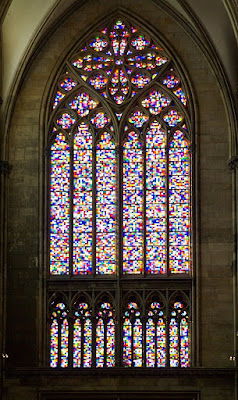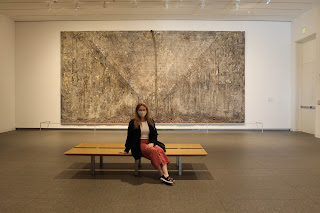Contrary to my other art historical posts on female, African American and Jewish artists, this group of artists (apart from the female component of it) has not really been overlooked historically and German artists remain well known all over the world. But my soon departure to the homeland made me want to elaborate on some of the most famous German artists of all time, in the hope that there will be some names or bios you weren't familiar with...
Albrecht Dürer (1471-1528)
 |
| "Self-portrait", 1498 |
One of the most famous artists of the Northern Renaissance, back when Germany was part of the Holy Roman Empire, a painter, printmaker and art theorist who influenced artists like Titian and Raphael. Similar to Leonardo da Vinci, he incorporated the rules of mathematics, perspective and proportions into his works; he was one of the first artists to popularize watercolors by painting his landscapes with them and gained popularity with the distribution of his woodcut prints across Europe, ultimately gaining him the patronage of Emperor Maximilian I.
Lucas Cranach the Elder (1472-1553)
 |
| "The Fall of Man", ca. 1537 |
Like Dürer, this is one of the biggest old German masters and one of the most prominent Renaissance painters and printmakers (with his prints being influenced by Dürer). He enjoyed success and a long life, was employed at the court of Friedrich the Wise in Wittenberg and was a supporter of the Protestant Reformation (that began in 1517 in the same city) and friend and portraitist of Martin Luther's. His son, Lucas Cranach the Younger, employed in his artists' workshop, became a famous painter as well.
Caspar David Friedrich (1774-1840)
 |
| "Wanderer above the Sea of Fog", 1818 |
While the Baroque didn't produce many world renown German masters, they re-entered the art stage in the beginning of the 19th century with the Romanticism movement whose famous protagonist is the Northern German Friedrich. Friedrich managed to reinvent the landscape painting by giving it a deeply personal and melancholic character. Nature seems at once precious and terrifying, holy and untamed, introduced through one (or several) figures that establish an emotional connection with the viewer. After a period of success, Friedrich was almost forgotten, unfashionable when he died; the importance of his works was reestablished in the 20th century.
Käthe Kollwitz (1867-1945)
 |
| "Hospital Visit", 1929 |
Kollwitz is one of the most famous female German artists, having worked as a painter, sculptor and printmaker, first in the new established German Empire, later during the Weimar Republic (the period between the two World Wars). Social aspects played an important role in her art, she depicted the lives of the poor, the sick, the suffering. Her son's death in a WWI battle encouraged her pacifism and socialist tendencies even more, therefore, she was not allowed to exhibit under the Nazi regime but managed to work until her death, shortly before the end of the war.
Gabriele Münter (1877-1962)
 |
| "Countryside near Paris", 1907 |
Gabriele studied at a female painting school because she was not allowed to join the Academy as a woman. But her talent led her to study under Wassily Kandinsy in Munich. The married older Russian artist and her started an affair, traveled together, discovered and adapted expressionism, collaborated with the European avant-garde. As Kandinsky had to return to Russia when WWI broke out, their relationship broke as well. After travels to Scandinavia and meeting a new partner, Gabriele lived seclusively in Murnau in Bavaria, her art defamed by the Nazis. After the war, she participated in the Kassel documenta 1, the first German exhibition of Modern Art after WWII.
Paul Klee (1879-1940)
 |
| "Camel (in a rhythmic landscape of trees)", 1920 |
Klee was a German-Swiss painter and graphic artist. His body of work ranges between cubism, surrealism, constructivism and expressionism. He also taught at the famous Bauhaus art school in Weimar alongside his friend Wassily Kandinsky. Once Hitler came to power in 1933, Klee had to return to Switzerland. His art was deemed "degenerate" - the Nazis classified all books and artworks as "degenerate" that were progressive, intellectual, critical or made by "enemies of the state", hence dangerous to the regime. Works by Klee and others were seized from German museums and sold abroad. He lost his professorship and his apartment: his family moved to Switzerland immediately, where he spent his last years.
Ernst Ludwig Kirchner (1880-1938)
 |
| "Alphütte", 1919 |
Kirchner was a self-taught artist who started one of the most famous German art moments, Die Brücke (the bridge), an association of expressionist painters in Dresden, that lasted from 1905 until 1913 when its members had a big falling out. Kirchner and Brücke painted modern scenes like the variete and the circus, used bold colors and showed big city life, people in motion, nudes. WWI came, Kirchner volunteered, but suffered a breakdown and became addicted to pain medication: in 1917, he moved to Switzerland, just like Klee. Once the Nazis classified his art as "degenerate", just like Klee's, Kirchner shot himself in the heart in 1938.
Max Beckmann (1884-1950)
 |
| "The Beginning", 1946-49 |
At a time when the majority of artists turned to abstraction, Beckmann developed a very distinctive figurative style to depict people. After he was fired from his teaching position and the touring exhibition called "Degenerate Art" exhibited his and other German artists' works to be mocked by the masses and to expose their supposed "venomous" character, he immigrated to the Netherlands and later to the United States where he painted the above pictured triptych - the story of his childhood - shortly before dying of a heart attack in the streets of Manhattan in 1950.
Max Ernst (1891-1976)
 |
| "The Frog", 1967, "Turtle", 1944, The Spirit of the Bastille", 1967 |
Ernst was a very influential and versatile artist. After serving in WWI, he started his artistic career as a Dadaist. He immigrated to France in the twenties to join the Surrealists, also working as a sculptor, living in a menage a trois with poet Paul Elouard and Gala, Salvador Dali's later wife. After being imprisoned by the Nazis in Paris, he had to flee to the US with his third wife, art collector Peggy Guggenheim; he was able to bring his Jewish son from his first wife, but she stayed behind and died in Auschwitz. In New York, Ernst started the drip painting technique that should become the most important element of Abstract Expressionism. He returned to Paris with his fourth wife, American artist Dorothea Tanning, in the 1950s.
Otto Dix (1891-1969)
 |
| Portrait of the journalist Sylvia von Harden, 1926 |
After fighting in WWI, young Dix became part of the German movement called New Objectivity - a reaction to expressionism, a return to realistic means, dominant in the Weimar Republic. Dix's works not only show the horrors of WWI but also explore "inappropriate" topics like prostitution and were therefore removed from German museums under the Nazi reign. Just like Beckmann's and Ernst's, Kirchner's and Klee's art, his too was shown at the "Degenerate art" exhibition. At the end of the war, 50-something Dix was forced to join the Nazi militia movement and for that he was captured by the French and held in an internment camp. He was realeased and his artistic reputation restored. The fate of a whole artist generation - the visionary and talented Klee, Kirchner, Beckmann, Ernst and Dix shows what havoc - beyond all the other destruction and trauma - Hitler and the National Socialist regime inflicted upon the German art world.
Joseph Beuys (1921-1986)
 |
| "Monument to the Stag", between 1958-85 |
Gerhard Richter (*1932)
 |
| "Symphony of Light", 2007 (stained glass window in the Cologne Cathedral) |
Richter is the most expensive living German artist and for a while, he has even held the title of the most expensive artist worldwide. His long life and rich oeuvre are marked by a tumultuous 20th century in Germany, the WWII, the division of the country (he managed to flee from East to West Germany right before the Wall was built), unification and reconciliation. Apart from photorealistic works (that he frequently blurs afterwards), he has created a unique abstract style that he achieves with a giant squeegee. In the cycle "Birkenau", he has initially worked photorealistically, only to "destroy" the unbearable, unforgivable images of the Holocaust with the squeegee.
Georg Baselitz (*1938)
 |
| "Volk Ding Zero", 2009 |
Baselitz's childhood and youth was, like Richter's, marked by the tragedy of war. He started painting upside down, "inverting" his objects, breaking with common, orderly perception. Humor is always present in Baselitz's work, both in paintings and sculptures, like in the one pictured above - a ridiculous, foolish seeming seated male figure - a playful reinterpretation of Rodin's "Thinker"? A self deprecating auto-portrait?
Anselm Kiefer (*1945)
 |
| "Ascheblume", 1983-97 |
Who's your favorite German artist? Or your least favorite?
Talk to you soon,
J.
PS: All images are from WikiCommons, apart form the last one :)









0 Comments